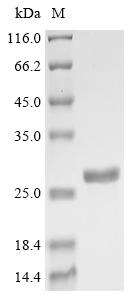Recombinant Pseudomonas fluorescens DNA-binding protein HU-beta (hupB)
CAT:
399-CSB-EP878312PAAW-01
Size:
20 µg
Price:
Ask
- Availability: 24/48H Stock Items & 2 to 6 Weeks non Stock Items.
- Dry Ice Shipment: No




Recombinant Pseudomonas fluorescens DNA-binding protein HU-beta (hupB)
- CAS Number: 9000-83-3
- Gene Name: hupB
- UniProt: Q9KHS6
- Expression Region: 1-90aa
- Organism: Pseudomonas fluorescens (strain ATCC BAA-477 / NRRL B-23932 / Pf-5)
- Target Sequence: MNKSELIDAIAASADLPKAAAGRALDAVIESVTGALKAGDSVVLVGFGTFSVTDRPARIGRNPQTGKTLEIAAAKKPGFKAGKALKEAVN
- Tag: N-terminal 6xHis-SUMO-tagged
- Source: E.coli
- Field of Research: Others
- Assay Type: Developed Protein
- Relevance: ATP-dependent RNA helicase involved in mRNA export from the nucleus. Rather than unwinding RNA duplexes, DDX19B functions as a remodeler of ribonucleoprotein particles, whereby proteins bound to nuclear mRNA are dissociated and replaced by cytoplasmic mRNA binding proteins .
- Purity: Greater than 85% as determined by SDS-PAGE.
- Activity: Not Test
- Length: Full Length
- Form: Liquid or Lyophilized powder
- Buffer: If the delivery form is liquid, the default storage buffer is Tris/PBS-based buffer, 5%-50% glycerol. If the delivery form is lyophilized powder, the buffer before lyophilization is Tris/PBS-based buffer, 6% Trehalose, pH 8.0.
- Reconstitution: We recommend that this vial be briefly centrifuged prior to opening to bring the contents to the bottom. Please reconstitute protein in deionized sterile water to a concentration of 0.1-1.0 mg/mL.We recommend to add 5-50% of glycerol (final concentration) and aliquot for long-term storage at -20℃/-80℃. Our default final concentration of glycerol is 50%. Customers could use it as reference.
- Molecular Weight: 22.1 kDa
- References & Citations: "A phospho-proteomic screen identifies substrates of the checkpoint kinase Chk1." Blasius M., Forment J.V., Thakkar N., Wagner S.A., Choudhary C., Jackson S.P. Genome Biol 12:R78-R78 (2011)
- Storage Conditions: The shelf life is related to many factors, storage state, buffer ingredients, storage temperature and the stability of the protein itself. Generally, the shelf life of liquid form is 6 months at -20℃/-80℃. The shelf life of lyophilized form is 12 months at -20℃/-80℃.
